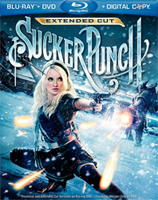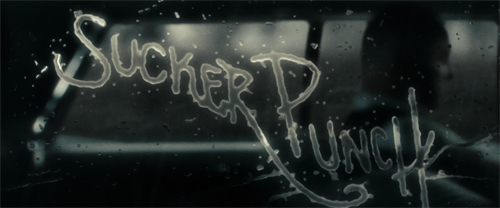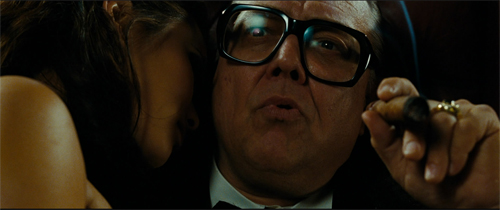 BUY IT AT AMAZON: Click HERE
BUY IT AT AMAZON: Click HERE
STUDIO: Warner Brothers
MSRP: $22.99
RATED: PG-13
RUNNING TIME: 110 Minutes
SPECIAL FEATURES:
Extended R-Rated Cut
Behind the Soundtrack Featurette
Motion Comics
Maximum Movie Mode
The Pitch
“It‘s Girl, Interrupted meets Enter the Void meets Zack Snyder!”
The Humans
Director: Zack Snyder
Writer: Zack Snyder, Steve Shibuya
Starring: Emily Browning, Jena Malone, Abbie Cornish, Vanessa Hudgens, Jamie Chung, Carla Gugino, Oscar Isaac, Jon Hamm, Scott Glenn
The Nutshell
Following the death of her mother and little sister, a young woman (Browning) is sent to an insane asylum, where she creates an elaborate fantasy world into which she can escape.
The Lowdown
Sucker Punch is a fascinating movie. I’ve seen it twice now (theatrical cut the first time, extended the second) and while I was quick to label it an “ambitious failure” initially, I almost think that might be selling it short, just a tad. That’s not to say that it’s wholly successful, but again it’s wildly ambitious and it sticks a whole hell of a lot more than you might have seen it given credit for. But perhaps I’m getting a little ahead of myself.
There have been plenty of criticisms lobbed at not only the movie, but at Snyder himself. And in fact, if taken at its harshest critics’ word, the film is a pretty complete visualization of everything that’s wrong with Snyder as a filmmaker: namely, that the guy is all style with no eye for story or script. And maybe so – Sucker Punch certainly isn’t a master class in storytelling or scriptwriting, but it’s incredibly rich and there’s a lot to chew on. The problem with the theatrical cut (as has been discussed hundreds of time in the months since its release), is that the story is indeed muddled and practically non-existent. The script is slight, motivations are muddy and some characters exist only to be bodies rounding out the cast. And again, after watching it initially I agreed with all of the criticisms – I tended to enjoy it more than some, but as much as I did indeed enjoy it, I would have been hard pressed to call it “good.”
But then there’s the extended, R-Rated cut. One of the additions is the insertion of the end-credits musical number (“Love is the Drug”) into the narrative, and while it’s lavish and well-executed it certainly really doesn’t have a place tonally and its excision makes sense. But, towards the end, there’s a scene inserted after Baby Doll creates the diversion that allows Sweet Pea to escape. In it, Jon Hamm, as the High Roller, works a seduction on a freshly made-up, half-naked and vulnerable Baby Doll. He explains to her that what he really wants is a moment of honesty, a moment in which he can know, with no uncertainty, that she wants what he’s about to do to her. That she welcomes it as an equal, willing participant; that he doesn’t have to take it by force. And in exchange for that one moment of honesty he offers her freedom from everything. From the day to day, from the pain, from everything she carries around with her. And okay, ostensibly it’s a grown man coercing a minor (?) into letting him take her virginity. So it makes sense that the MPAA would be a little squirmy about letting that fly with a PG-13 intact. But here’s why the MPAA is full of it – cutting that scene robs the film of that last little bit of context it needs to sew everything up and in cutting it, Snyder (the studio, more likely) sacrificed a story for a rating.
But that little bit of indignation aside, what that scene adds to the proceedings is that Baby Doll sees the High Roller as a savior and when she says she wants to escape this place, it’s not as literal as it seems. Once you realize the High Roller’s place in all of this, Baby Doll’s projections onto the other characters become much more clear.
It’s not a stretch to see Madame Gorsky as her mother and Blue as the stepfather, but what becomes much more clear is the fact that Sweet Pea and Rocket end up representing Baby Doll and her own little sister. It’s not surprising that Rocket is the one character given the most personality (even more than Baby Doll herself) and it’s because Baby Doll wanted more than anything to see her little sister grown up. Rocket still has to die though, because Baby Doll knows she can’t change what happened. Sweet Pea, in turn, becomes a projection of Baby Doll herself. When Baby helps Sweet Pea escape, it’s Baby Doll coming to terms with everything and forgiving herself. It’s almost like she’s fractured her own imagination and compartmentalized her psyche, letting everything that’s negative die with Baby Doll at the hands of the High Roller and giving herself a fresh start and a new direction in everything she’s projected into Sweet Pea. An idea that’s given weight by Sweet Pea’s bus escape being the last thing we see before the credits roll.
Now, obviously, that doesn’t do a lot to alleviate the script problems and the criticisms lobbed against the mixed messages of empowerment vs. fetishism and the lack of clarity about what was real and what wasn’t what with the specific revelations that came after the lobotomy. But this is where Snyder’s weaknesses as a storyteller might actually serve the film. The important thing to remember is that Baby Doll is, for all intents and purposes, a kid. And she’s been irreparably damaged to the point where a frontal lobotomy is an escape to look forward to. Her outlook is broken and bleak and she has nothing left and everything that happens is processed through the mind of THAT character. Baby Doll’s life has fallen into the control of people who see her as nothing more than a product to be bought and sold and it makes sense that the world she escapes into is a whorehouse. The criticisms, of course, come at the fact that when Baby Doll recesses deeper into her own mind – into an area in which she empowers herself to fight back – she and her fellow ladies are still dolled up in fetish garb, Baby Doll’s own bright blonde pig-tails and rather shameless flailing about in micro-skirts being the most damning examples. But while the criticisms of mixed messages are valid, it‘s also worth exploring that maybe it‘s a case of Baby Doll using her objectification as empowerment. She knows that her dancing‘s hypnotic power comes from the blatant lustful objectification these people project upon her, and she spends the entire film using it to her advantage. Her fighting the fantasy battles in that attire seems like her way of saying “Yes, I’ll give you exactly what you want and I’m gonna use it to get everything I need.” And what I think Snyder‘s trying to say with that is that it only works because the men are dumb enough to fall for it. It’s a sort of commentary on the fact that most men do indeed have a one-track mind when it comes to women. What Blue sees as a way to break these girls’ spirits and keep them subservient, Baby Doll sees as a way to subvert the system and turn against him. What the Stepdad saw as an easy out, Baby Doll used as an escape and a catharsis and what it really is depends on how you look at it. Did the Stepdad win? Well it depends on what you consider a victory. If he was trying to kill Baby Doll in total then no, it wasn’t because she used the entire experience to free herself from everything he caused and start over. And in that sense, even if she wasn’t able to shed a light on him for what he had done and who he was, she still won because she managed to free and forgive herself. There’s a whole commentary on duality here and while it’s clumsy and at times problematic because of how clumsy it gets, it’s extremely interesting and shows a depth to Snyder that’s easy to gloss over because of how superficially glitzy the visuals SEEM. In fact, the visually over-indulgent fantasy sections tie back into that as well and goes back to what I said about Snyder’s weaknesses as a storyteller working to actually serve the story in the context of this particular film. Just like Baby Doll’s dancing hypnotizes the men watching it and gives her a chance to work her agenda covertly, Snyder’s action sequences do the same thing in that if you get too caught up in just watching you’re going to miss everything that’s being done right under your noses. And no, it doesn’t always succeed as Snyder is definitely one to get lost in his own sense of style and he doesn‘t always know exactly how to say what he‘s trying to say, but the intent is always there.
And in the end, I think that’s the central idea of what Sucker Punch – and by extension, Snyder – is in a critical sense; it’s the equivalent of someone standing up to give a moving, stirring, powerful speech, and actually having something really meaningful to say, but stopping every so often to say “What’s that word I’m looking for?” and rambling for a sentence or two to try and cover before he gets back to his point. Granted, he’s given us more than enough information in context to have a pretty good idea of what word he’s looking for, but that’s not how a great artist and a great communicator operates and, as of yet, Snyder is neither of those things. But you can tell he wants to be. Snyder swung for the fences with Sucker Punch, but while others call it a strike out, I’m more inclined to call it a foul ball. And at this point I‘m extremely anxious to see what he does next, as it’s either going to make or break his legacy as an artist.
The Package
The artwork is a teency bit generic, with Baby Doll in a rather provocative pose dodging the bullets from the giant machine-gunner samurai. The only thing good about it is the title treatment, which, tangentially, was totally buggered in the film itself. That title logo looks great in its full-color design; the water-droplet treatment did it a severe injustice.
Features include, of course, the extended cut, which I’ve devoted all of the above to talking about, the Maximum Movie Mode which is like live commentary, BTS materials, storyboards and interviews all given the PiP treatment while you’re watching. I got about halfway through the film watching it like this and while it might be a tiny bit disorganized it was still pretty interesting. I watched a couple of the handful of motion comics and while they looked really good, after having watched the movie twice (and then another half a time for the Max Mode) I was a bit burned out, but apparently they give a bit of insight into the backstories of the other girls and their place in the fantasy worlds.
The Soundtrack Featurette is pretty much fluff, it basically talks about the songs they used and how Emily sang the majority of them.
The Verdict: It’s a DEFINITE renter, as even if the movie doesn’t work for you it’s without a doubt worth at least a watch, and because it is a Blu and it is a Zack Snyder film, it looks amazing and the sound mix is pretty bitchin, so it could even find a home on your shelf as a demo disc for your theater set up.





